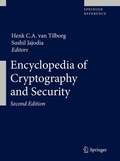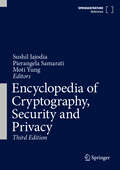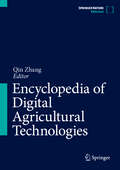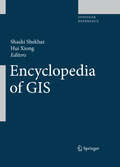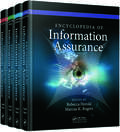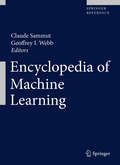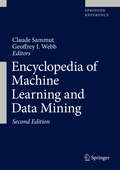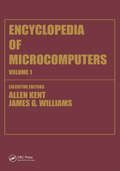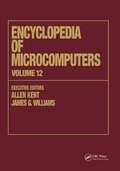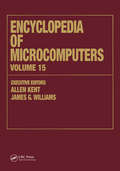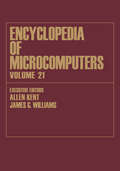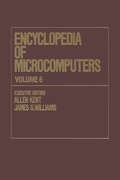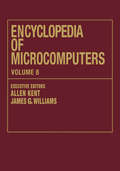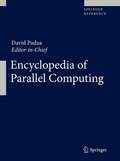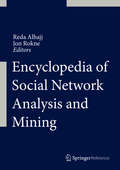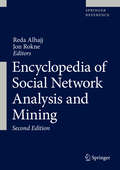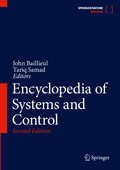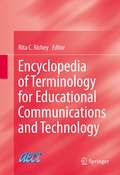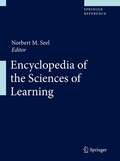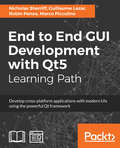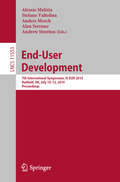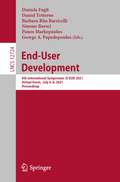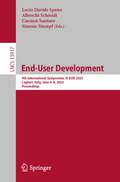- Table View
- List View
Encyclopedia of Cryptography and Security
by Sushil Jajodia Henk C.A. TilborgExpanded into two volumes, the Second Edition of Springer's Encyclopedia of Cryptography and Security brings the latest and most comprehensive coverage of the topic: Definitive information on cryptography and information security from highly regarded researchers Effective tool for professionals in many fields and researchers of all levels Extensive resource with more than 700 contributions in Second Edition 5643 references, more than twice the number of references that appear in the First Edition With over 300 new entries, appearing in an A-Z format, the Encyclopedia of Cryptography and Security provides easy, intuitive access to information on all aspects of cryptography and security. As a critical enhancement to the First Edition's base of 464 entries, the information in the Encyclopedia is relevant for researchers and professionals alike. Topics for this comprehensive reference were elected, written, and peer-reviewed by a pool of distinguished researchers in the field. The Second Edition's editorial board now includes 34 scholars, which was expanded from 18 members in the First Edition. Representing the work of researchers from over 30 countries, the Encyclopedia is broad in scope, covering everything from authentication and identification to quantum cryptography and web security. The text's practical style is instructional, yet fosters investigation. Each area presents concepts, designs, and specific implementations. The highly-structured essays in this work include synonyms, a definition and discussion of the topic, bibliographies, and links to related literature. Extensive cross-references to other entries within the Encyclopedia support efficient, user-friendly searches for immediate access to relevant information. Key concepts presented in the Encyclopedia of Cryptography and Security include: Authentication and identification; Block ciphers and stream ciphers; Computational issues; Copy protection; Cryptanalysis and security; Cryptographic protocols; Electronic payment and digital certificates; Elliptic curve cryptography; Factorization algorithms and primality tests; Hash functions and MACs; Historical systems; Identity-based cryptography; Implementation aspects for smart cards and standards; Key management; Multiparty computations like voting schemes; Public key cryptography; Quantum cryptography; Secret sharing schemes; Sequences; Web Security. Topics covered: Data Structures, Cryptography and Information Theory; Data Encryption; Coding and Information Theory; Appl.Mathematics/Computational Methods of Engineering; Applications of Mathematics; Complexity. This authoritative reference will be published in two formats: print and online. The online edition features hyperlinks to cross-references, in addition to significant research.
Encyclopedia of Cryptography, Security and Privacy
by Sushil Jajodia Moti Yung Pierangela SamaratiA rich stream of papers and many good books have been written on cryptography, security, and privacy, but most of them assume a scholarly reader who has the time to start at the beginning and work his way through the entire text. The goal of Encyclopedia of Cryptography, Security, and Privacy, Third Edition is to make important notions of cryptography, security, and privacy accessible to readers who have an interest in a particular concept related to these areas, but who lack the time to study one of the many books in these areas. The third edition is intended as a replacement of Encyclopedia of Cryptography and Security, Second Edition that was edited by Henk van Tilborg and Sushil Jajodia and published by Springer in 2011. The goal of the third edition is to enhance on the earlier edition in several important and interesting ways. First, entries in the second edition have been updated when needed to keep pace with the advancement of state of the art. Second, as noticeable already from the title of the encyclopedia, coverage has been expanded with special emphasis to the area of privacy. Third, considering the fast pace at which information and communication technology is evolving and has evolved drastically since the last edition, entries have been expanded to provide comprehensive view and include coverage of several newer topics.
Encyclopedia of Digital Agricultural Technologies
by Qin ZhangDigital agriculture is an emerging concept of modern farming that refers to managing farms using modern Engineering, Information and Communication Technologies (EICT) aiming at increasing the overall efficiency of agricultural production, improving the quantity and quality of products, and optimizing the human labor required and natural resource consumption in operations. This encyclopedia is designed to collect the summaries of knowledge on as many as subjects or aspects relevant to ECIT for digital agriculture, present such knowledge in entries, and arrange them alphabetically by articles titles.Springer Major Reference Works platform offers Live Update capability. Our reference work takes full advantage of this feature, which allows for continuous improvement or revision of published content electronically.The Editorial BoardDr. Irwin R. Donis-Gonzalez, University of California Davis, Dept. Biological and Agricultural Engineering, Davis, USA (Section: Postharvest Technologies)Prof. Paul Heinemann, Pennsylvania State University, Department Head of Agricultural and Biological Engineering, PA, USA (Section: Technologies for Crop Production)Prof. Manoj Karkee, Washington State University, Center for Precision and Automated Agricultural Systems, Washington, USA (Section: Robotics and Automation Technologies)Prof. Minzan Li, China Agricultural University, Beijing, China (Section: Precision Agricultural Technologies)Prof. Dikai Liu, University of Technology Sydney (UTS),Faculty of Engineering & Information Technologies, Broadway NSW, Australia (Section: AI, Information and Communication Technologies)Prof. Tomas Norton, University of Leuven, Dept. of Biosystems, Heverlee Leuven, Belgium (Section: Technologies for Animal and Aquatic Production)Dr. Manuela Zude-Sasse, Leibniz Institute for Agricultural Engineering and Bioeconomy (ATB), Precision Horticulture, Potsdam, Germany (Section: Engineering and Mechanization Technologies)
Encyclopedia of GIS
by Shashi Shekhar Hui XiongThe Encyclopedia of GIS provides a comprehensive and authoritative guide, contributed by experts and peer-reviewed for accuracy, and alphabetically arranged for convenient access. The entries explain key software and processes used by geographers and computational scientists. Major overviews are provided for nearly 200 topics: Geoinformatics, Spatial Cognition, and Location-Based Services and more. Shorter entries define specific terms and concepts. The reference will be published as a print volume with abundant black and white art, and simultaneously as an XML online reference with hyperlinked citations, cross-references, four-color art, links to web-based maps, and other interactive features.
Encyclopedia of Information Assurance - 4 Volume Set (Print)
by Rebecca Herold and Marcus K. RogersCharged with ensuring the confidentiality, integrity, availability, and delivery of all forms of an entity's information, Information Assurance (IA) professionals require a fundamental understanding of a wide range of specializations, including digital forensics, fraud examination, systems engineering, security risk management, privacy, and compliance. Establishing this understanding and keeping it up to date requires a resource with coverage as diverse as the field it covers. Filling this need, the Encyclopedia of Information Assurance presents an up-to-date collection of peer-reviewed articles and references written by authorities in their fields. From risk management and privacy to auditing and compliance, the encyclopedia’s four volumes provide comprehensive coverage of the key topics related to information assurance. This complete IA resource: Supplies the understanding needed to help prevent the misuse of sensitive information Explains how to maintain the integrity of critical systems Details effective tools, techniques, and methods for protecting personal and corporate data against the latest threats Provides valuable examples, case studies, and discussions on how to address common and emerging IA challenges Placing the wisdom of leading researchers and practitioners at your fingertips, this authoritative reference provides the knowledge and insight needed to avoid common pitfalls and stay one step ahead of evolving threats.Also Available OnlineThis Taylor & Francis encyclopedia is also available through online subscription, offering a variety of extra benefits for researchers, students, and librarians, including: Citation tracking and alerts Active reference linking Saved searches and marked lists HTML and PDF format optionsContact Taylor and Francis for more information or to inquire about subscription options and print/online combination packages.US: (Tel) 1.888.318.2367; (E-mail) e-reference@taylorandfrancis.comInternational: (Tel) +44 (0) 20 7017 6062; (E-mail) online.sales@tandf.co.uk
Encyclopedia of Machine Learning
by Claude Sammut Geoffrey I. WebbThis comprehensive encyclopedia, in A-Z format, provides easy access to relevant information for those seeking entry into any aspect within the broad field of Machine Learning. Most of the entries in this preeminent work include useful literature references.
Encyclopedia of Machine Learning and Data Mining
by Claude Sammut Geoffrey I. WebbThis authoritative, expanded and updated second edition of Encyclopedia of Machine Learning and Data Mining provides easy access to core information for those seeking entry into any aspect within the broad field of Machine Learning and Data Mining. A paramount work, its 800 entries - about 150 of them newly updated or added - are filled with valuable literature references, providing the reader with a portal to more detailed information on any given topic. Topics for the Encyclopedia of Machine Learning and Data Mining include Learning and Logic, Data Mining, Applications, Text Mining, Statistical Learning, Reinforcement Learning, Pattern Mining, Graph Mining, Relational Mining, Evolutionary Computation, Information Theory, Behavior Cloning, and many others. Topics were selected by a distinguished international advisory board. Each peer-reviewed, highly-structured entry includes a definition, key words, an illustration, applications, a bibliography, and links to related literature. The entries are expository and tutorial, making this reference a practical resource for students, academics, or professionals who employ machine learning and data mining methods in their projects. Machine learning and data mining techniques have countless applications, including data science applications, and this reference is essential for anyone seeking quick access to vital information on the topic.
Encyclopedia of Microcomputers: Volume 1 - Access Methods to Assembly Language and Assemblers
by Allen Kent; James G. Williams; Rosalind Kent"The Encyclopedia of Microcomputers serves as the ideal companion reference to the popular Encyclopedia of Computer Science and Technology. Now in its 10th year of publication, this timely reference work details the broad spectrum of microcomputer technology, including microcomputer history; explains and illustrates the use of microcomputers throughout academe, business, government, and society in general; and assesses the future impact of this rapidly changing technology."
Encyclopedia of Microcomputers: Volume 12 - Multistrategy Learning to Operations Research: Microcomputer Applications (Microcomputers Encyclopedia)
by James G. Williams Allen Kent Carolyn M. Hall Rosalind Kent"The Encyclopedia of Microcomputers serves as the ideal companion reference to the popular Encyclopedia of Computer Science and Technology. Now in its 10th year of publication, this timely reference work details the broad spectrum of microcomputer technology, including microcomputer history; explains and illustrates the use of microcomputers throughout academe, business, government, and society in general; and assesses the future impact of this rapidly changing technology."
Encyclopedia of Microcomputers: Volume 15 - Reporting on Parallel Software to SNOBOL
by Allen Kent; James G. Williams; Carolyn M. Hall; Rosalind Kent"The Encyclopedia of Microcomputers serves as the ideal companion reference to the popular Encyclopedia of Computer Science and Technology. Now in its 10th year of publication, this timely reference work details the broad spectrum of microcomputer technology, including microcomputer history; explains and illustrates the use of microcomputers throughout academe, business, government, and society in general; and assesses the future impact of this rapidly changing technology."
Encyclopedia of Microcomputers: Volume 21 - Index
by James G. Williams Allen KentThis volume contains information about the automatic acquisition of biographic knowledge from encyclopedic texts, Web interaction and the navigation problem in hypertext.
Encyclopedia of Microcomputers: Volume 6 - Electronic Dictionaries in Machine Translation to Evaluation of Software: Microsoft Word Version 4.0 (Microcomputers Encyclopedia Ser.)
by James G. Williams Allen Kent"The Encyclopedia of Microcomputers serves as the ideal companion reference to the popular Encyclopedia of Computer Science and Technology. Now in its 10th year of publication, this timely reference work details the broad spectrum of microcomputer technology, including microcomputer history; explains and illustrates the use of microcomputers throughout academe, business, government, and society in general; and assesses the future impact of this rapidly changing technology."
Encyclopedia of Microcomputers: Volume 8 - Geographic Information System to Hypertext (Microcomputers Encyclopedia Ser.)
by James G. Williams Allen Kent Carolyn M. Hall Rosalind Kent"The Encyclopedia of Microcomputers serves as the ideal companion reference to the popular Encyclopedia of Computer Science and Technology. Now in its 10th year of publication, this timely reference work details the broad spectrum of microcomputer technology, including microcomputer history; explains and illustrates the use of microcomputers throughout academe, business, government, and society in general; and assesses the future impact of this rapidly changing technology."
Encyclopedia of Parallel Computing
by David PaduaContaining over 300 entries in an A-Z format, the Encyclopedia of Parallel Computing provides easy, intuitive access to relevant information for professionals and researchers seeking access to any aspect within the broad field of parallel computing. Topics for this comprehensive reference were selected, written, and peer-reviewed by an international pool of distinguished researchers in the field. The Encyclopedia is broad in scope, covering machine organization, programming languages, algorithms, and applications. Within each area, concepts, designs, and specific implementations are presented. The highly-structured essays in this work comprise synonyms, a definition and discussion of the topic, bibliographies, and links to related literature. Extensive cross-references to other entries within the Encyclopedia support efficient, user-friendly searchers for immediate access to useful information. Key concepts presented in the Encyclopedia of Parallel Computing include; laws and metrics; specific numerical and non-numerical algorithms; asynchronous algorithms; libraries of subroutines; benchmark suites; applications; sequential consistency and cache coherency; machine classes such as clusters, shared-memory multiprocessors, special-purpose machines and dataflow machines; specific machines such as Cray supercomputers, IBM's cell processor and Intel's multicore machines; race detection and auto parallelization; parallel programming languages, synchronization primitives, collective operations, message passing libraries, checkpointing, and operating systems. Topics covered: Speedup, Efficiency, Isoefficiency, Redundancy, Amdahls law, Computer Architecture Concepts, Parallel Machine Designs, Benmarks, Parallel Programming concepts & design, Algorithms, Parallel applications. This authoritative reference will be published in two formats: print and online. The online edition features hyperlinks to cross-references and to additional significant research. Related Subjects: supercomputing, high-performance computing, distributed computing
Encyclopedia of Social Network Analysis and Mining
by Jon Rokne Reda AlhajjEncyclopedia of Social Network Analysis and Mining
Encyclopedia of Social Network Analysis and Mining
by Jon Rokne Reda AlhajjSocial Network Analysis and Mining Encyclopedia (ESNAM) is the first major reference work to integrate fundamental concepts and research directions in the areas of social networks and applications to data mining. The second edition of ESNAM is a truly outstanding reference appealing to researchers, practitioners, instructors and students (both undergraduate and graduate), as well as the general public. This updated reference integrates all basics concepts and research efforts under one umbrella. Coverage has been expanded to include new emerging topics such as crowdsourcing, opinion mining, and sentiment analysis. Revised content of existing material keeps the encyclopedia current. The second edition is intended for college students as well as public and academic libraries. It is anticipated to continue to stimulate more awareness of social network applications and research efforts.The advent of electronic communication, and in particular on-line communities, have created social networks of hitherto unimaginable sizes. Reflecting the interdisciplinary nature of this unique field, the essential contributions of diverse disciplines, from computer science, mathematics, and statistics to sociology and behavioral science, are described among the 300 authoritative yet highly readable entries. Students will find a world of information and insight behind the familiar façade of the social networks in which they participate. Researchers and practitioners will benefit from a comprehensive perspective on the methodologies for analysis of constructed networks, and the data mining and machine learning techniques that have proved attractive for sophisticated knowledge discovery in complex applications. Also addressed is the application of social network methodologies to other domains, such as web networks and biological networks.
Encyclopedia of Software Engineering Three-Volume Set (Print)
by Phillip A. LaplanteSoftware engineering requires specialized knowledge of a broad spectrum of topics, including the construction of software and the platforms, applications, and environments in which the software operates as well as an understanding of the people who build and use the software. Offering an authoritative perspective, the two volumes of the Encyclopedia of Software Engineering cover the entire multidisciplinary scope of this important field. More than 200 expert contributors and reviewers from industry and academia across 21 countries provide easy-to-read entries that cover software requirements, design, construction, testing, maintenance, configuration management, quality control, and software engineering management tools and methods. Editor Phillip A. Laplante uses the most universally recognized definition of the areas of relevance to software engineering, the Software Engineering Body of Knowledge (SWEBOK®), as a template for organizing the material. Also available in an electronic format, this encyclopedia supplies software engineering students, IT professionals, researchers, managers, and scholars with unrivaled coverage of the topics that encompass this ever-changing field. Also Available OnlineThis Taylor & Francis encyclopedia is also available through online subscription, offering a variety of extra benefits for researchers, students, and librarians, including: Citation tracking and alerts Active reference linking Saved searches and marked lists HTML and PDF format options Contact Taylor and Francis for more information or to inquire about subscription options and print/online combination packages.US: (Tel) 1.888.318.2367; (E-mail) e-reference@taylorandfrancis.comInternational: (Tel) +44 (0) 20 7017 6062; (E-mail) online.sales@tandf.co.uk
Encyclopedia of Systems and Control
by John Baillieul Tariq SamadThe Encyclopedia of Systems and Control collects a broad range of short expository articles that describe the current state of the art in the central topics of control and systems engineering as well as in many of the related fields in which control is an enabling technology. The editors have assembled the most comprehensive reference possible, and this has been greatly facilitated by the publisher’s commitment to continuously publish updates to the articles as they become available in the future. Although control engineering is now a mature discipline, it remains an area in which there is a great deal of research activity, and as new developments in both theory and applications become available, they will be included in the online version of the encyclopedia. A carefully chosen team of leading authorities in the field has written the well over 300 articles, 50 of them new in the second edition. The topics range from basic principles of feedback in servomechanisms to advanced topics such as the control of Boolean networks and evolutionary game theory and this range has also been expanded to include material on such subjects as the Internet of Things, quantum control and smart grids. Because the content has been selected to reflect both foundational importance and subjects that are of current interest to the research and practitioner communities, a broad readership that includes students, application engineers, and research scientists will find entries that are of interest.
Encyclopedia of Terminology for Educational Communications and Technology
by Rita C RicheyThe Encyclopedia of Terminology for Educational Communications and Technology is a volume of scholarly definitions and short discussions of approximately 180 key terms of the field. Each 200-500 word entry includes material such as the salient attributes of the term, any alternative views and interpretations of the term, and future trends. The definition discussions are supported with relevant literature from educational communications and technology and related fields, such as communications or educational psychology. Individual signed entries are written by over 50 established scholars from throughout the field and throughout the world. The terms included in the encyclopedia cover the many topics addressed by the field's practitioners and scholars. They encompass six general categories of educational technology content - foundational subjects, instructional design, technology and media, analysis and evaluation, management and organizational improvement, and research and theory.
Encyclopedia of the Sciences of Learning
by Norbert M. SeelOver the past century, educational psychologists and researchers have posited many theories to explain how individuals learn, i.e. how they acquire, organize and deploy knowledge and skills. The 20th century can be considered the century of psychology on learning and related fields of interest (such as motivation, cognition, metacognition etc.) and it is fascinating to see the various mainstreams of learning, remembered and forgotten over the 20th century and note that basic assumptions of early theories survived several paradigm shifts of psychology and epistemology. Beyond folk psychology and its naïve theories of learning, psychological learning theories can be grouped into some basic categories, such as behaviorist learning theories, connectionist learning theories, cognitive learning theories, constructivist learning theories, and social learning theories. Learning theories are not limited to psychology and related fields of interest but rather we can find the topic of learning in various disciplines, such as philosophy and epistemology, education, information science, biology, and - as a result of the emergence of computer technologies - especially also in the field of computer sciences and artificial intelligence. As a consequence, machine learning struck a chord in the 1980s and became an important field of the learning sciences in general. As the learning sciences became more specialized and complex, the various fields of interest were widely spread and separated from each other; as a consequence, even presently, there is no comprehensive overview of the sciences of learning or the central theoretical concepts and vocabulary on which researchers rely. The Encyclopedia of the Sciences of Learning provides an up-to-date, broad and authoritative coverage of the specific terms mostly used in the sciences of learning and its related fields, including relevant areas of instruction, pedagogy, cognitive sciences, and especially machine learning and knowledge engineering. This modern compendium will be an indispensable source of information for scientists, educators, engineers, and technical staff active in all fields of learning. More specifically, the Encyclopedia provides fast access to the most relevant theoretical terms provides up-to-date, broad and authoritative coverage of the most important theories within the various fields of the learning sciences and adjacent sciences and communication technologies; supplies clear and precise explanations of the theoretical terms, cross-references to related entries and up-to-date references to important research and publications. The Encyclopedia also contains biographical entries of individuals who have substantially contributed to the sciences of learning; the entries are written by a distinguished panel of researchers in the various fields of the learning sciences.
End Game (The Midnight Library #3)
by Damien GravesSimon prefers computer games to reality, but a shockingly real turn of events might mean "Game Over" -- forever. This story and two additional contributions equal three more ways to define the word "fear".
End to End GUI Development with Qt5: Develop cross-platform applications with modern UIs using the powerful Qt framework
by Guillaume Lazar Robin Penea Nicholas Sherriff Marco PiccolinoLearn the complete Qt ecosystem and its tools and build UIs for mobile and desktop applicationsKey FeaturesUnleash the power of the latest Qt 5.9 with C++14Easily compile, run, and debug your applications from the powerful Qt Creator IDEBuild multi-platform projects that target Android, iOS, Windows, MacOS, Linux, and moreBook DescriptionQt 5.9 is an application development framework that provides a great user experience and develops full-capability applications with Qt Widgets, QML, and even Qt 3D. This learning path demonstrates the power and flexibility of the Qt framework for desktop application development and shows how you can write an application once and deploy it to multiple operating systems. It will address all the challenges while developing cross-platform applications with the Qt framework.This course will give you a better understanding of the Qt framework and tools to resolve serious issues such as linking, debugging, and multithreading. It will also upskill you by explaining how to create a to-do-style app and taking you through all the stages in building a successful project. You will build a suite of apps; while developing these apps, you’ll deepen your knowledge of Qt Quick's layout systems, and see Qt 3D and widgets in action. The next project will be in the industrial and agricultural sectors: making sense of sensor data via a monitoring system. Your apps should run seamlessly across devices and operating systems such as Android, iOS, Windows, or Mac, and be cost-effective by integrating with existing web technologies. You take the role of lead developer and prototype a monitoring system. In doing so, you’ll get to know Qt's Bluetooth and HTTP APIs, as well as the Charts and Web Engine UI modules. These projects will help you gain a holistic view of the Qt framework.What you will learnInstall and configure the Qt Framework and Qt Creator IDEImplement a rich user interface with QMLLearn the fundamentals of QtTest and how to integrate unit testingCreate stunning UIs with Qt Widget and Qt QuickDevelop powerful, cross-platform applications with the Qt frameworkDesign GUIs with Qt Designer and build a library in it for UI previewsBuild a desktop UI with widgets and DesignerGet familiar with multimedia components to handle visual input and outputWho this book is forThis book will appeal to developers and programmers who would like to build GUI-based applications. Knowledge of C++ is necessary and a basic familiarity with Qt would be helpful.
End-User Development: 7th International Symposium, IS-EUD 2019, Hatfield, UK, July 10–12, 2019, Proceedings (Lecture Notes in Computer Science #11553)
by Stefano Valtolina Alessio Malizia Anders Morch Alan Serrano Andrew StrattonThis book constitutes the refereed proceedings of the 7th International Symposium on End-User Development, IS-EUD 2017, held in Hatfield, UK, in July 2019. The 9 full papers and 8 short papers presented were carefully reviewed and selected from 35 submissions. The papers discuss progress in research around end-user development through, or towards, methods, socio-technical environments, intelligent agents, as well as the most effective end-user programming paradigms for smart environments. Papers and submissions in all categories addressed this specific theme together with topics that have been traditionally covered by the broader themes of end-user development, such as domain specific tools, spreadsheets, educational applications, and end user aspects.
End-User Development: 8th International Symposium, IS-EUD 2021, Virtual Event, July 6–8, 2021, Proceedings (Lecture Notes in Computer Science #12724)
by Panos Markopoulos Barbara Rita Barricelli George A. Papadopoulos Simone Borsci Daniela Fogli Daniel TetterooThis book constitutes the proceedings of the 8th International Conference on End-User Development, IS-EUD 2021, held in July 2021. Due to COVID-19 pandemic the conference was held virtually.The paper track received 26 submissions, of which 11 full and 4 short papers were selected after a rigorous double-blind review process. The papers focus on “Democratizing AI development”, namely on EUD for AI-based systems, where end users are called-on to become end-user developers of intelligent agents, digital twins, collaborative systems and social robots.
End-User Development: 9th International Symposium, IS-EUD 2023, Cagliari, Italy, June 6–8, 2023, Proceedings (Lecture Notes in Computer Science #13917)
by Albrecht Schmidt Simone Stumpf Lucio Davide Spano Carmen SantoroThis book constitutes the refereed proceedings of the 9th International Symposium on End-User Development, IS-EUD 2023, held in Cagliari, Italy, during June 6–8, 2023.The 17 full papers and 2 (keynote extended abstracts) included in this book were carefully reviewed and selected from 26 submissions. They were organized in topical sections as follows: Artificial Intelligence for End-Users; Internet of Things for End-Users; Privacy; Security and Society; Supporting End-User Development.
